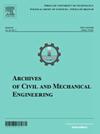Friction and wear characteristics and simulation study of NM500 lining plate in ball mill under different load conditions
Abstract
Friction and wear test equipment, scanning electron microscope, abrasion balls made of CGr15 high carbon chromium bearing steel, and liners made of NM500 steel were used for wear simulation and friction–wear experiments. The variation trends of friction coefficient, wear amount, and sub-surface characteristics under dry friction and slurry conditions were studied. Simulations supported the research results. The results show that the pressure and the coefficient of friction vary inversely. The coefficient of friction between the abrasive ball and the lining plate decreases with the increase of the load. Samples subjected to a pressure of 120N have higher values of Kernel Average Misorientation (KAM) and lower recrystallization ratios compared to samples subjected to a pressure of 130N. In a slurry environment, the difference in wear surface depth decreases to 0 μm (120N) and 5 μm (130N). This change indicates that the presence of the slurry alters the wear characteristics of the surfaces, leading to a reduction in the depth difference between the surfaces under different load conditions. This observation highlights the importance of considering the influence of the slurry environment on friction and wear behavior in simulations and experiments.


 求助内容:
求助内容: 应助结果提醒方式:
应助结果提醒方式:


